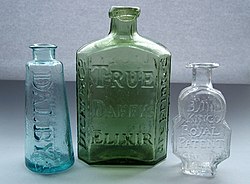
A patent medicine, also known as a proprietary medicine or a nostrum (from the Latin nostrum remedium, or "our remedy") is a commercial product advertised to consumers as an over-the-counter medicine, generally for a variety of ailments, without regard to its actual effectiveness or the potential for harmful side effects. The earliest patent medicines were created in the 17th century. They were most popular from the mid-19th century to the early 20th century, before the advent of consumer protection laws and evidence-based medicine. [1] [2] Despite the name, patent medicines were usually trademarked but not actually patented, in order to keep their formulas secret. [3] [4]
Contents
- Types of patent medicine
- Notable brand names
- Surviving brands and products
- Discontinued products
- See also
- References
Patent medicines often included alcohol and drugs such as opium as active ingredients. [5] Addiction and overdose were common as a result. [6] [7] Some formulations included toxic ingredients such as arsenic, lead, and mercury. [8] Other ingredients like sarsaparilla and wintergreen may have been medically inert and largely harmless, but lacked significant medical benefits. [9] It was rare for any patent medication to be pharmacologically effective, and none lived up to the miraculous promises made by their advertising. [9]
Patent medicine advertising was typically outlandish, eye-catching, and had little basis in reality. [10] Advertisements emphasized exotic or scientific-sounding ingredients, featured endorsements from purported experts or celebrities, and often claimed that products were universal remedies or panaceas. [11] Beginning in the early 20th century, the passage of consumer protection laws in countries like the United Kingdom, United States, and Canada began to regulate deceptive advertising and put limits on what ingredients could be used in medicines, putting an end to the dominance of patent medicines. [2] [12] [13] Although some modern alternative medicines bear similarities to patent medicines, the term most typically refers to remedies created before modern regulations, and the scope of this list reflects that. [14] [15] [16] [17]







